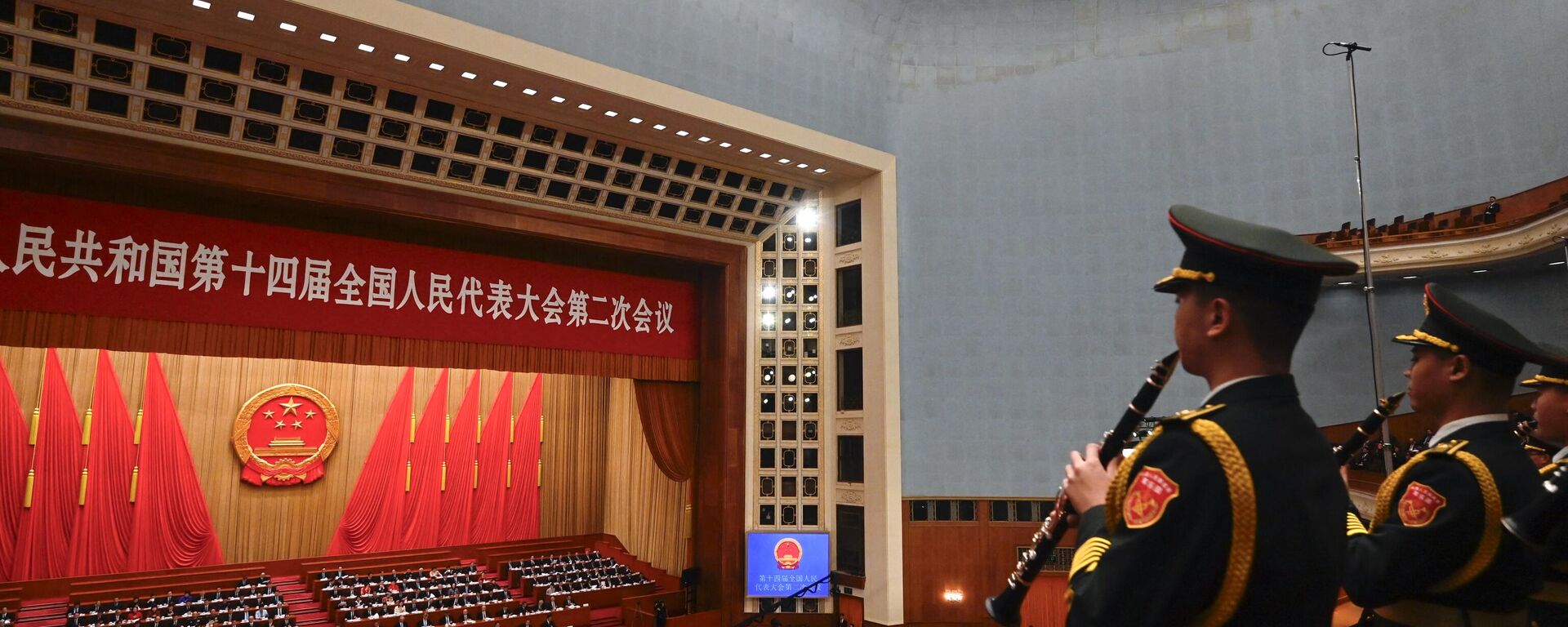https://sputnikglobe.com/20240305/china-defense-spending-boost-to-go-to-emerging-tech-as-ukraine-previews-future-battlefield-1117148773.html
China’s Defense Spending Boost to Go to Emerging Tech as Ukraine Previews ‘Future Battlefield’
China’s Defense Spending Boost to Go to Emerging Tech as Ukraine Previews ‘Future Battlefield’
Sputnik International
Chinese Premier Li Qiang has outlined the People’s Republic’s near-term development priorities, including economic growth, defense spending and the battle with the West for technological supremacy. Sputnik turned to a leading Beijing-based economist for his take on the Asian economic giant’s ambitious plans.
2024-03-05T18:50+0000
2024-03-05T18:50+0000
2024-03-05T19:06+0000
analysis
china
beijing
taiwan
sputnik
national people’s congress
pla
https://cdn1.img.sputnikglobe.com/img/07e6/08/05/1098146551_0:98:3072:1826_1920x0_80_0_0_62659629990f4cc256cb4d9c290eda06.jpg
In a working report submitted Tuesday at the annual meeting of China’s National People’s Congress parliament, Premier Li previewed the nation’s economic, defense and foreign policy strategy for the coming year, signaling a GDP growth target of “around 5 percent” for 2024, and outlining structural adjustments aimed at “transforming” the current growth model.Li’s report highlighted the need to expand domestic demand and promote stable consumer spending, take measures to further ensure the nation’s food security, open the door for private investment in areas including telecommunications and medical services, expand foreign trade, and scrap thresholds for foreign investment in Chinese manufacturing. Li also announced plans for a multi-trillion-yuan package of long-term treasury bonds to fund large priority development initiatives.Also featuring in the report was a plan to “mobilize resources nationwide to raise China’s capacity for innovation across the board,” which Li said include plans to “pool our country’s strategic scientific and technological strength and non-government innovation resources to make breakthroughs in core technologies in key fields and step up research into disruptive and frontier technologies.”Specifically, China, which is already one of the world’s top scientific and technical powers, is looking to increase spending on research and development by about 10 percent, and to gain self-sufficiency in areas ranging from artificial intelligence to microchips, and make inroads in biomanufacturing, quantum technology, hydrogen power, commercial spaceflight and the digital economy.On defense, Li mentioned plans to boost defense spending by 7.2 percent, to 1.66 trillion yuan (about $230 billion US), with Beijing committing to “comprehensively strengthen military training and combat readiness,” and “firmly safeguard” its “national sovereignty, security, and development interests.”Li emphasized China’s pursuit of an independent but at the same time peaceful foreign policy, decrying “external interference” in Taiwan, and reiterating that Beijing will continue to “resolutely oppose ‘Taiwan independence’ separatism…and promote cross-strait relations and peaceful development.”Growth Estimates ‘Conservative’“What [Premier Li] said exactly is ‘about 5 percent’ [growth], which means it can be a bit more or a bit less than 5 percent,” Dr. John Gong, a professor of economics at the Beijing-based University of International Business and Economics, told Sputnik. Gong pointed out that in the first two months of 2024, China has already showed signs of a “robust recovery” from an economic slump which began last fall, particularly in the service sector, with “even the real estate sector, which has been dragging the feet of the economy in China” with a series of high profile bankruptcies, “show[ing] signs of stabilizing,” according to the professor.As for technology and R&D, Gong said the prioritized commitment of resources to these “very critical areas” signals that China doesn’t want to fall behind the West, particularly amid “a fair amount of hi-tech choking and boycotting by Washington,” a situation Gong predicts will only become worse with time.Defense Priorities in PerspectiveWith the legacy media rushing to characterize the jump in Chinese defense spending announced by Li as a “push for global heft” or even a sign of a potential bid to resolve the Taiwan issue by force, Dr. Gong emphasized that the 7.2 percent growth rate must be seen in perspective, matching the pace of growth seen in 2023 and not even constituting the largest spending bump in recent years.That’s despite the fact that China’s economy by nominal GDP is roughly 70 percent of America’s – and surpassed the US in purchasing power parity terms in 2016.
https://sputnikglobe.com/20240305/how-much-will-china-spend-on-defense–economic-strength-1117139583.html
https://sputnikglobe.com/20240303/west-braces-for-new-china-shock-as-beijing-brings-back-export-oriented-development-strategy-1117106302.html
https://sputnikglobe.com/20230914/us-plan-to-contain-china-rehearsed-in-ukraine-1113365490.html
china
beijing
taiwan
2024
News
en_EN
https://cdn1.img.sputnikglobe.com/img/07e6/08/05/1098146551_199:0:2930:2048_1920x0_80_0_0_18f0705c5fbee881e65a38130e9dc54c.jpg
what are china’s development priorities, what are china’s priorities in 2024, how does china plan to overtake the west technologically, how much does china spend on defense
what are china’s development priorities, what are china’s priorities in 2024, how does china plan to overtake the west technologically, how much does china spend on defense
Chinese Premier Li Qiang has outlined the People’s Republic’s near-term development priorities, including economic growth, defense spending and the battle with the West for technological supremacy. Sputnik turned to a leading Beijing-based economist for his take on the Asian economic giant’s ambitious plans.
Li’s report highlighted the need to expand domestic demand and promote stable consumer spending, take measures to further ensure the nation’s food security, open the door for private investment in areas including telecommunications and medical services, expand foreign trade, and scrap thresholds for foreign investment in Chinese manufacturing. Li also announced plans for a multi-trillion-yuan package of long-term treasury bonds to fund large priority development initiatives.
Also featuring in the report was a plan to “mobilize resources nationwide to raise China’s capacity for innovation across the board,” which Li said include plans to “pool our country’s strategic scientific and technological strength and non-government innovation resources to make breakthroughs in core technologies in key fields and step up research into disruptive and frontier technologies.”
Specifically, China, which is already one of the world’s top scientific and technical powers, is looking to increase spending on research and development by about 10 percent, and to gain self-sufficiency in areas ranging from artificial intelligence to microchips, and make inroads in biomanufacturing, quantum technology, hydrogen power, commercial spaceflight and the digital economy.
On defense, Li mentioned plans to boost defense spending by 7.2 percent, to 1.66 trillion yuan (about $230 billion US), with Beijing committing to “comprehensively strengthen military training and combat readiness,” and “firmly safeguard” its “national sovereignty, security, and development interests.”
Li emphasized China’s pursuit of an independent but at the same time peaceful foreign policy, decrying “external interference” in Taiwan, and reiterating that Beijing will continue to “resolutely oppose ‘Taiwan independence’ separatism…and promote cross-strait relations and peaceful development.”
Growth Estimates ‘Conservative’
“What [Premier Li] said exactly is ‘about 5 percent’ [growth], which means it can be a bit more or a bit less than 5 percent,” Dr. John Gong, a professor of economics at the Beijing-based University of International Business and Economics, told Sputnik.
“That is actually the same goal [China had] in 2023, and in the end we achieved a 5.2 percent growth rate last year. I think we are going to see a similar picture here. The Chinese government typically sets a fairly conservative goal and most likely it is going to achieve that goal,” he said.
Gong pointed out that in the first two months of 2024, China has already showed signs of a “robust recovery” from an economic slump which began last fall, particularly in the service sector, with “even the real estate sector, which has been dragging the feet of the economy in China” with a series of high profile bankruptcies, “show[ing] signs of stabilizing,” according to the professor.
China’s growth rate targets are all the more impressive, Gong said, given that the PRC’s economy is “increasingly looking like a ‘developed economy’, where normally a 4-5 percent growth rate is already a great achievement.”
As for technology and R&D, Gong said the prioritized commitment of resources to these “very critical areas” signals that China doesn’t want to fall behind the West, particularly amid “a fair amount of hi-tech choking and boycotting by Washington,” a situation Gong predicts will only become worse with time.
“So the Chinese government is bent on self-reliance and indigenous development. It doesn’t have a choice. The good news is that the corporate world moves very fast in terms of using and developing these new technologies,” the academic said.
Defense Priorities in Perspective
“From 2017 to 2023, the growth rates have been, respectively, 7 percent, 8.1 percent, 7.5 percent, 6.6 percent, 6.8 percent, 7.1 percent and 7.2 percent. So this year’s 7.2 percent is in the middle range. We have to keep things in perspective, as China’s defense budget has been historically small compared to the United States. China is going to spend about US$238 billion on defense in 2024, while Washington’s defense budget is close to US$900 billion,” the professor pointed out.
That’s despite the fact that China’s economy by nominal GDP is roughly 70 percent of America’s – and surpassed the US in purchasing power parity terms in 2016.
“In terms of where the defense budget will be spent, I would guess an increasing portion will be spent on emerging technologies in defense. The war in Ukraine tells a lot about what the future battlefield will look [like], and I am pretty sure PLA generals are keeping a close eye on what is happing in the Donbass and Zaporozhye,” Gong summarized.




